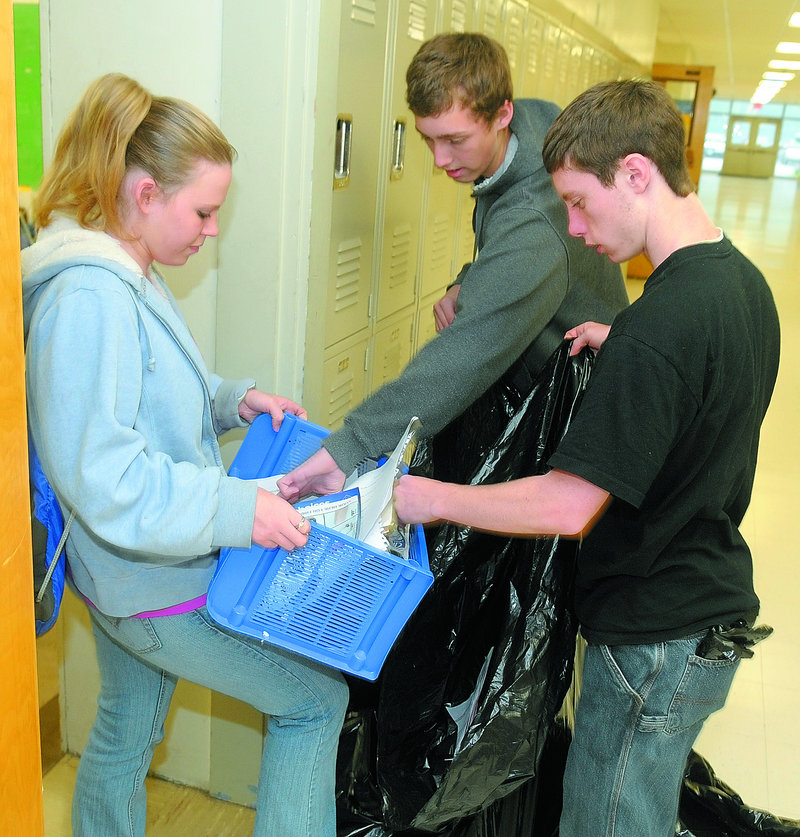FARMINGDALE – Megan Barton was looking for hands-on experience and a departure from purely academic work when she enrolled in the Jobs for Maine’s Graduates class as a Hall-Dale High School sophomore.
“I signed up hoping to get help with figuring out what I wanted to do with my life,” the 18-year-old from Whitefield said.
Three years later, Barton is preparing to graduate from high school and has plans to start working toward a nursing degree at Kennebec Valley Community College in Fairfield in the fall.
Without Jobs for Maine’s Graduates, Barton said, “I don’t know if I’d be going to college next year.”
State education officials want more students to have the opportunity Barton had: to explore different career paths and higher education opportunities; to learn the skills needed to interview successfully for a job; and to become involved in community service.
That’s why the Maine Department of Education has made Jobs for Maine’s Graduates a focal point in its application for up to $75 million in federal funds aimed at spurring education reform.
Maine’s application for money in the federal Race to the Top competition — which was due June 1 — proposes using some of the funds to expand the dropout prevention program to at least 25 more schools statewide.
Jobs for Maine’s Graduates “has been experiencing some cuts in its funding from other sources. We wanted to make sure this program continued,” said David Connerty-Marin, the Department of Education spokesman. “If we’re able to get those funds, that would be an important part of our work.”
The Maine Legislature created the program in 1993 as a way to reach students considered at risk of not finishing high school. It is offered to students as a regular school class period but operates as a nonprofit organization.
Students can enroll in Jobs for Maine’s Graduates classes if they show they have a personal barrier that might prevent them from completing high school, said Craig Larrabee, the program’s president and chief executive officer. Those include family or social issues, high absenteeism, academic struggles and low family income.
“We see (the program) as a tool in the tool chest for those schools that are looking to turn around their performance and improve their offering to kids, giving every kid the opportunity to be successful,” Larrabee said.
Jobs for Maine’s Graduates receives 30 percent of its funds from state government, 35 percent from the schools that house programs and the rest from private contributions, largely from Maine businesses.
Sixty-four Maine middle and high schools have Jobs for Maine’s Graduates programs, Larrabee said, serving 4,000 students. And there’s a waiting list of schools that want Jobs for Maine’s Graduates classes.
For Barton, the Hall-Dale High School senior, the Jobs for Maine’s Graduates class allowed her to learn about different career paths directly from people “in a lot of different businesses.” That made an impact, she said.
Barton also had the chance in class to sharpen leadership, communication and teamwork skills and receive help on college and scholarship applications.
Joe Ingalls, a Hall-Dale junior from Farmingdale, signed up for Jobs for Maine’s Graduates with hopes of getting out of the classroom more often to perform community service.
This school year, he’s taken part in a class outing to help at the Special Olympics and helped organize a basketball competition between Hall-Dale and Gardiner school staff and the Harlem Superstars comedy basketball team.
“(It) was a good way to get out there and do more in the community,” said Ingalls, 18.
“We try to get out of the classroom as much as possible,” said Susan Emmet, Hall-Dale’s Jobs for Maine’s Graduates specialist.
The skills Ingalls learned also helped him nail the interview for the job he starts on Monday, as a waiter at Granite Hill Estates in Hallowell.
“I would have gone for the interview, but I think it would have been a lot harder without (the program),” he said.
The Race to the Top education reform challenge puts an emphasis on initiatives that boost high school graduation rates. And according to Larrabee, Jobs for Maine’s Graduates has a proven track record in accomplishing that.
“The data really supports (it) as a good investment,” he said.
Jobs for Maine’s Graduates reports 92 percent of its students graduate from high school, compared to a 78 percent overall graduation rate for Maine students.
Six years after high school, the program’s statistics show, Jobs for Maine’s Graduates alumni are, on average, making 14 percent more than others in their age group.
If the federal government selects Maine as a Race to the Top winner, the state plans to use part of the money to expand Jobs for Maine’s Graduates to schools labeled low-performing: Those struggling to boost low standardized test scores and low graduation rates.
“Our goal is to scale up programs that have been successful in the state through pilot programs, or ongoing programs,” Connerty-Marin said.
Larrabee estimates that would mean Jobs for Maine’s Graduates programs in 25 more schools.
“The system’s in place,” he said. “It’s just a matter of finding the dollars to expand it.”
Send questions/comments to the editors.



Success. Please wait for the page to reload. If the page does not reload within 5 seconds, please refresh the page.
Enter your email and password to access comments.
Hi, to comment on stories you must . This profile is in addition to your subscription and website login.
Already have a commenting profile? .
Invalid username/password.
Please check your email to confirm and complete your registration.
Only subscribers are eligible to post comments. Please subscribe or login first for digital access. Here’s why.
Use the form below to reset your password. When you've submitted your account email, we will send an email with a reset code.